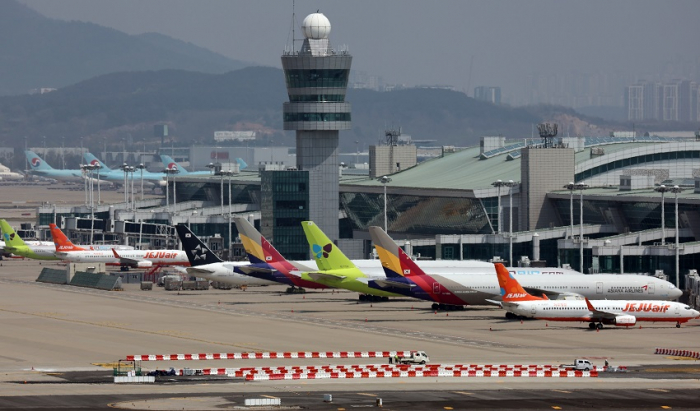Airlines
Korea airlines grounded by oil, currency, interest rates
Higher interest rates and a weaker won increase airlines’ costs when jet fuel prices have already surged
By Jun 17, 2022 (Gmt+09:00)
2
Min read
Most Read
LG Chem to sell water filter business to Glenwood PE for $692 million


Kyobo Life poised to buy Japan’s SBI Group-owned savings bank


KT&G eyes overseas M&A after rejecting activist fund's offer


StockX in merger talks with Naver’s online reseller Kream


Mirae Asset to be named Korea Post’s core real estate fund operator



South Korea’s airlines are suffering from surging oil prices, a weaker won and rising interest rates as the global border reopening has yet to translate into a full-fledged demand recovery for international flights.
The US Federal Reserve on Wednesday took its most aggressive tightening step since 1994 by raising the target federal fund rate by 75 basis points (bps). That prompted expectations that the Bank of Korea may increase interest rates by 50 bps, more than its usual adjustment of 25 bps.
Higher interest rates are bad for airlines since they lease a lot of their aircraft. The country’s top carrier Korean Air Lines Co. must spend 45 billion won ($34.8 million) more in yearly borrowing costs with each 1-percentage-point rise in the average interest rate, while its smaller rival Asiana Airlines Inc. has to pay 32.8 billion won for the same increase.
A weaker won also increases local airlines’ costs as they usually make payments for aircraft leases and fuel purchases in dollars. Korean Air estimated a foreign exchange valuation loss of some 41 billion won for the South Korean currency weakening by just 10 won against the greenback. Asiana is also likely to suffer a 28.4 billion won loss for the same currency change.
Global oil prices kept rising, ramping up fuel costs that account for about 20-30% of airlines' fixed costs. The global jet fuel price surged 128.1% to $176.56 per barrel on June 10 from a year earlier, according to the International Air Transport Association.
BUDGET AIRLINES HIT HARDEST
The triple whammy was toughest on the country’s low-cost carriers, which have been in the red for more than two years.
“The fixed costs have about doubled,” said a source at one of the budget airlines. “We have no choice but to hope for a recovery in market conditions as soon as possible by increasing the supply of flights and lifting COVID-19 regulations.”
Demand for passenger flights is gradually reviving but remains far from pre-pandemic levels. The number of international flight passengers at Incheon International Airport, the country’s hub airport, totaled 617,533 in the first 16 days of this month, about fivefold from the 123,275 a year earlier. But that was less than 20% of 3.1 million in the same period of 2019 before COVID-19 broke out.
A local body for the private sector’s pilot urged the government to extend financial support for LCCs.
The government has been providing special support packages to industries that COVID-19 hit including airlines to maintain payrolls.
“About 40% of LCC employees are still on paid leave as the government’s remaining COVID-19 restrictions on entrants limit travel demand from increasing and Japan, a key destination, has not allowed entry without a visa,” said the Airline Pilots Association of Korea. “The payment of the employment support fund, which is scheduled to end this month, should be extended to the end of the year.”
Write to Jeong Min Nam at peux@hankyung.com
Jongwoo Cheon edited this article.
More to Read
-
 AirlinesGlobal airlines raise flights to pre-COVID levels on border reopening
AirlinesGlobal airlines raise flights to pre-COVID levels on border reopeningMar 14, 2022 (Gmt+09:00)
4 Min read
Comment 0
LOG IN


